NUR3201 Assignment: Case Analysis of Troy Almond's Death and Findings
VerifiedAdded on 2022/09/18
|11
|3049
|20
Report
AI Summary
This report analyzes the case of Troy Almond, a child who died shortly after being discharged from the hospital, focusing on the failures in nursing practice and electronic documentation. The analysis examines the role of RNs Shaun Avis and Pamela Mason, and Dr. Babak Tajvidi, highlighting the importance of adhering to established protocols, particularly the "Between the Flags" (BTF) system and the "Pediatric Sepsis Pathway." The report discusses the accountability of RNs in using electronic communication and documentation systems, emphasizing the need for accurate record-keeping and clear communication of vital signs. It explores the significance of early warning tools, such as the BTF structure and the implementation of Ryan's Rule and R.E.A.C.H, to improve patient safety and prevent adverse outcomes. The report concludes by emphasizing the importance of comprehensive initial assessments, effective communication among colleagues, and adherence to established policies to prevent similar incidents in the future.
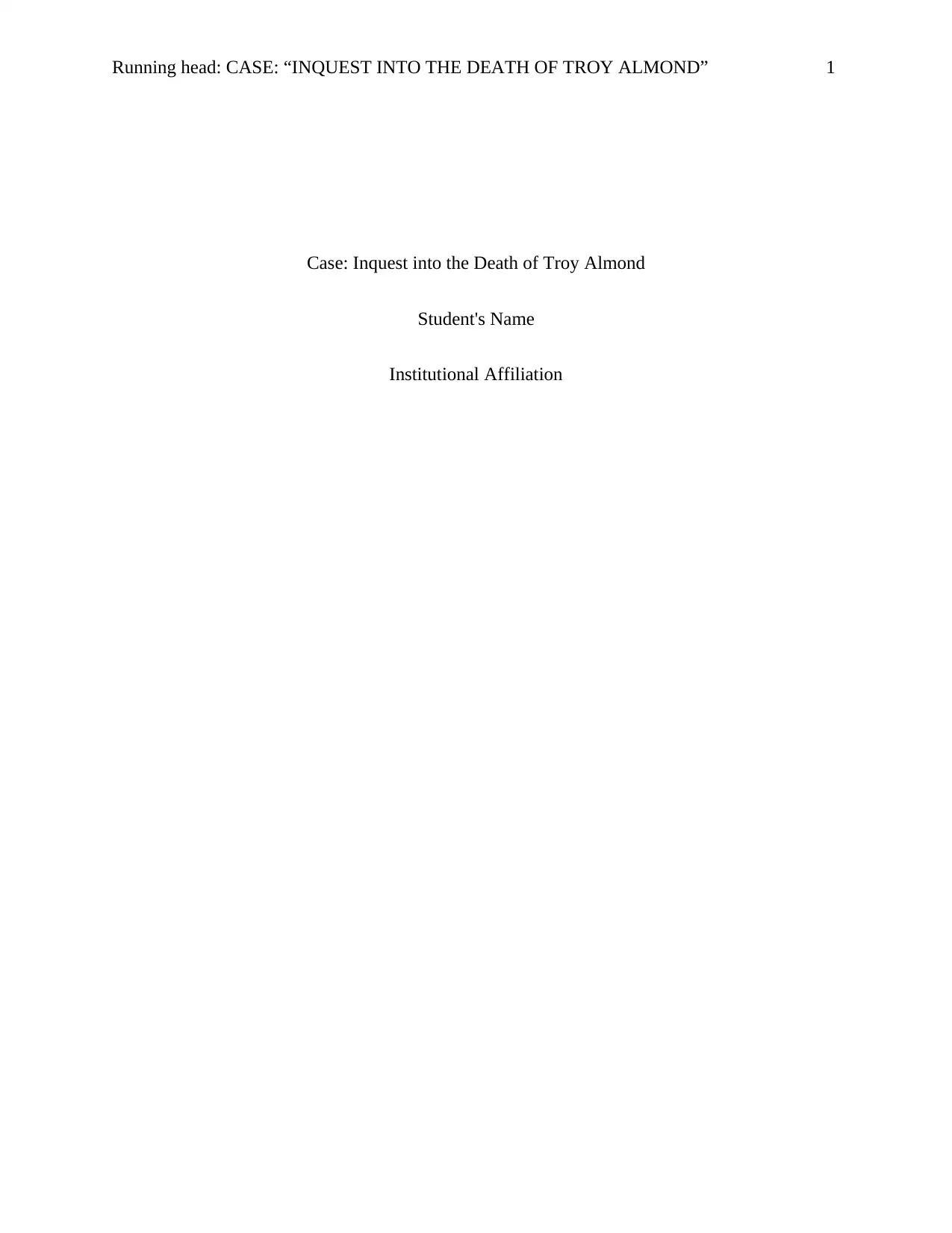
Running head: CASE: “INQUEST INTO THE DEATH OF TROY ALMOND” 1
Case: Inquest into the Death of Troy Almond
Student's Name
Institutional Affiliation
Case: Inquest into the Death of Troy Almond
Student's Name
Institutional Affiliation
Paraphrase This Document
Need a fresh take? Get an instant paraphrase of this document with our AI Paraphraser
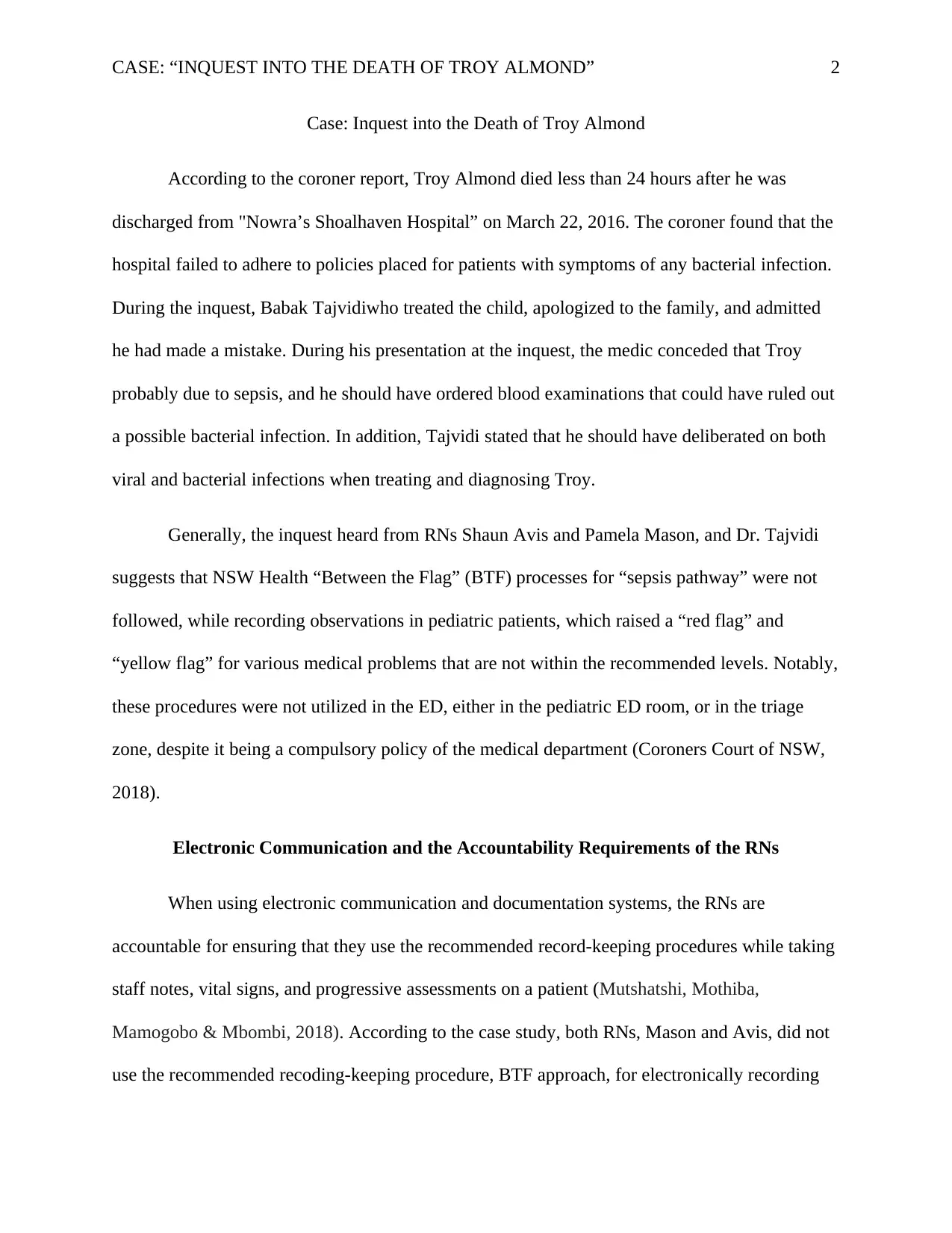
CASE: “INQUEST INTO THE DEATH OF TROY ALMOND” 2
Case: Inquest into the Death of Troy Almond
According to the coroner report, Troy Almond died less than 24 hours after he was
discharged from "Nowra’s Shoalhaven Hospital” on March 22, 2016. The coroner found that the
hospital failed to adhere to policies placed for patients with symptoms of any bacterial infection.
During the inquest, Babak Tajvidiwho treated the child, apologized to the family, and admitted
he had made a mistake. During his presentation at the inquest, the medic conceded that Troy
probably due to sepsis, and he should have ordered blood examinations that could have ruled out
a possible bacterial infection. In addition, Tajvidi stated that he should have deliberated on both
viral and bacterial infections when treating and diagnosing Troy.
Generally, the inquest heard from RNs Shaun Avis and Pamela Mason, and Dr. Tajvidi
suggests that NSW Health “Between the Flag” (BTF) processes for “sepsis pathway” were not
followed, while recording observations in pediatric patients, which raised a “red flag” and
“yellow flag” for various medical problems that are not within the recommended levels. Notably,
these procedures were not utilized in the ED, either in the pediatric ED room, or in the triage
zone, despite it being a compulsory policy of the medical department (Coroners Court of NSW,
2018).
Electronic Communication and the Accountability Requirements of the RNs
When using electronic communication and documentation systems, the RNs are
accountable for ensuring that they use the recommended record-keeping procedures while taking
staff notes, vital signs, and progressive assessments on a patient (Mutshatshi, Mothiba,
Mamogobo & Mbombi, 2018). According to the case study, both RNs, Mason and Avis, did not
use the recommended recoding-keeping procedure, BTF approach, for electronically recording
Case: Inquest into the Death of Troy Almond
According to the coroner report, Troy Almond died less than 24 hours after he was
discharged from "Nowra’s Shoalhaven Hospital” on March 22, 2016. The coroner found that the
hospital failed to adhere to policies placed for patients with symptoms of any bacterial infection.
During the inquest, Babak Tajvidiwho treated the child, apologized to the family, and admitted
he had made a mistake. During his presentation at the inquest, the medic conceded that Troy
probably due to sepsis, and he should have ordered blood examinations that could have ruled out
a possible bacterial infection. In addition, Tajvidi stated that he should have deliberated on both
viral and bacterial infections when treating and diagnosing Troy.
Generally, the inquest heard from RNs Shaun Avis and Pamela Mason, and Dr. Tajvidi
suggests that NSW Health “Between the Flag” (BTF) processes for “sepsis pathway” were not
followed, while recording observations in pediatric patients, which raised a “red flag” and
“yellow flag” for various medical problems that are not within the recommended levels. Notably,
these procedures were not utilized in the ED, either in the pediatric ED room, or in the triage
zone, despite it being a compulsory policy of the medical department (Coroners Court of NSW,
2018).
Electronic Communication and the Accountability Requirements of the RNs
When using electronic communication and documentation systems, the RNs are
accountable for ensuring that they use the recommended record-keeping procedures while taking
staff notes, vital signs, and progressive assessments on a patient (Mutshatshi, Mothiba,
Mamogobo & Mbombi, 2018). According to the case study, both RNs, Mason and Avis, did not
use the recommended recoding-keeping procedure, BTF approach, for electronically recording
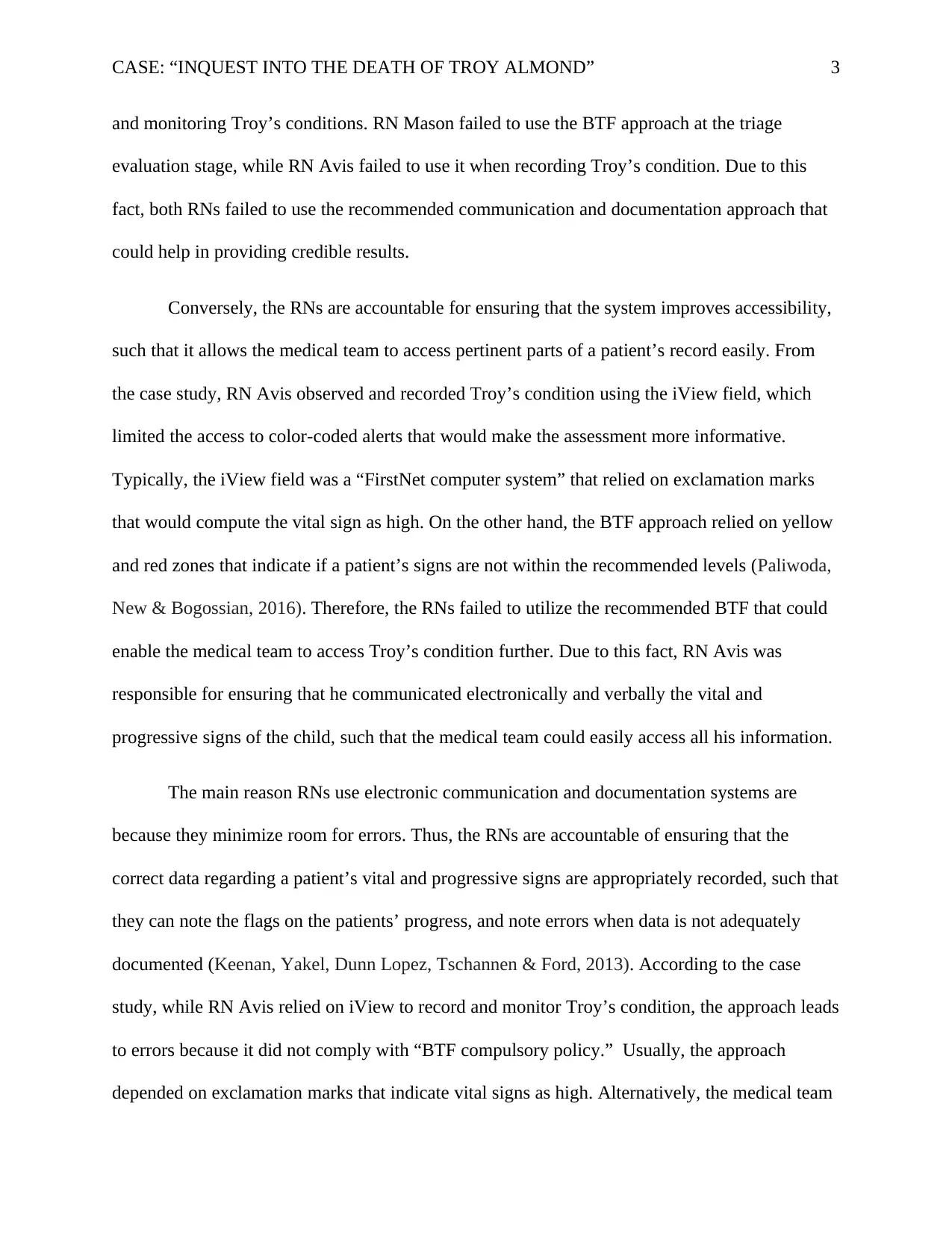
CASE: “INQUEST INTO THE DEATH OF TROY ALMOND” 3
and monitoring Troy’s conditions. RN Mason failed to use the BTF approach at the triage
evaluation stage, while RN Avis failed to use it when recording Troy’s condition. Due to this
fact, both RNs failed to use the recommended communication and documentation approach that
could help in providing credible results.
Conversely, the RNs are accountable for ensuring that the system improves accessibility,
such that it allows the medical team to access pertinent parts of a patient’s record easily. From
the case study, RN Avis observed and recorded Troy’s condition using the iView field, which
limited the access to color-coded alerts that would make the assessment more informative.
Typically, the iView field was a “FirstNet computer system” that relied on exclamation marks
that would compute the vital sign as high. On the other hand, the BTF approach relied on yellow
and red zones that indicate if a patient’s signs are not within the recommended levels (Paliwoda,
New & Bogossian, 2016). Therefore, the RNs failed to utilize the recommended BTF that could
enable the medical team to access Troy’s condition further. Due to this fact, RN Avis was
responsible for ensuring that he communicated electronically and verbally the vital and
progressive signs of the child, such that the medical team could easily access all his information.
The main reason RNs use electronic communication and documentation systems are
because they minimize room for errors. Thus, the RNs are accountable of ensuring that the
correct data regarding a patient’s vital and progressive signs are appropriately recorded, such that
they can note the flags on the patients’ progress, and note errors when data is not adequately
documented (Keenan, Yakel, Dunn Lopez, Tschannen & Ford, 2013). According to the case
study, while RN Avis relied on iView to record and monitor Troy’s condition, the approach leads
to errors because it did not comply with “BTF compulsory policy.” Usually, the approach
depended on exclamation marks that indicate vital signs as high. Alternatively, the medical team
and monitoring Troy’s conditions. RN Mason failed to use the BTF approach at the triage
evaluation stage, while RN Avis failed to use it when recording Troy’s condition. Due to this
fact, both RNs failed to use the recommended communication and documentation approach that
could help in providing credible results.
Conversely, the RNs are accountable for ensuring that the system improves accessibility,
such that it allows the medical team to access pertinent parts of a patient’s record easily. From
the case study, RN Avis observed and recorded Troy’s condition using the iView field, which
limited the access to color-coded alerts that would make the assessment more informative.
Typically, the iView field was a “FirstNet computer system” that relied on exclamation marks
that would compute the vital sign as high. On the other hand, the BTF approach relied on yellow
and red zones that indicate if a patient’s signs are not within the recommended levels (Paliwoda,
New & Bogossian, 2016). Therefore, the RNs failed to utilize the recommended BTF that could
enable the medical team to access Troy’s condition further. Due to this fact, RN Avis was
responsible for ensuring that he communicated electronically and verbally the vital and
progressive signs of the child, such that the medical team could easily access all his information.
The main reason RNs use electronic communication and documentation systems are
because they minimize room for errors. Thus, the RNs are accountable of ensuring that the
correct data regarding a patient’s vital and progressive signs are appropriately recorded, such that
they can note the flags on the patients’ progress, and note errors when data is not adequately
documented (Keenan, Yakel, Dunn Lopez, Tschannen & Ford, 2013). According to the case
study, while RN Avis relied on iView to record and monitor Troy’s condition, the approach leads
to errors because it did not comply with “BTF compulsory policy.” Usually, the approach
depended on exclamation marks that indicate vital signs as high. Alternatively, the medical team
⊘ This is a preview!⊘
Do you want full access?
Subscribe today to unlock all pages.

Trusted by 1+ million students worldwide
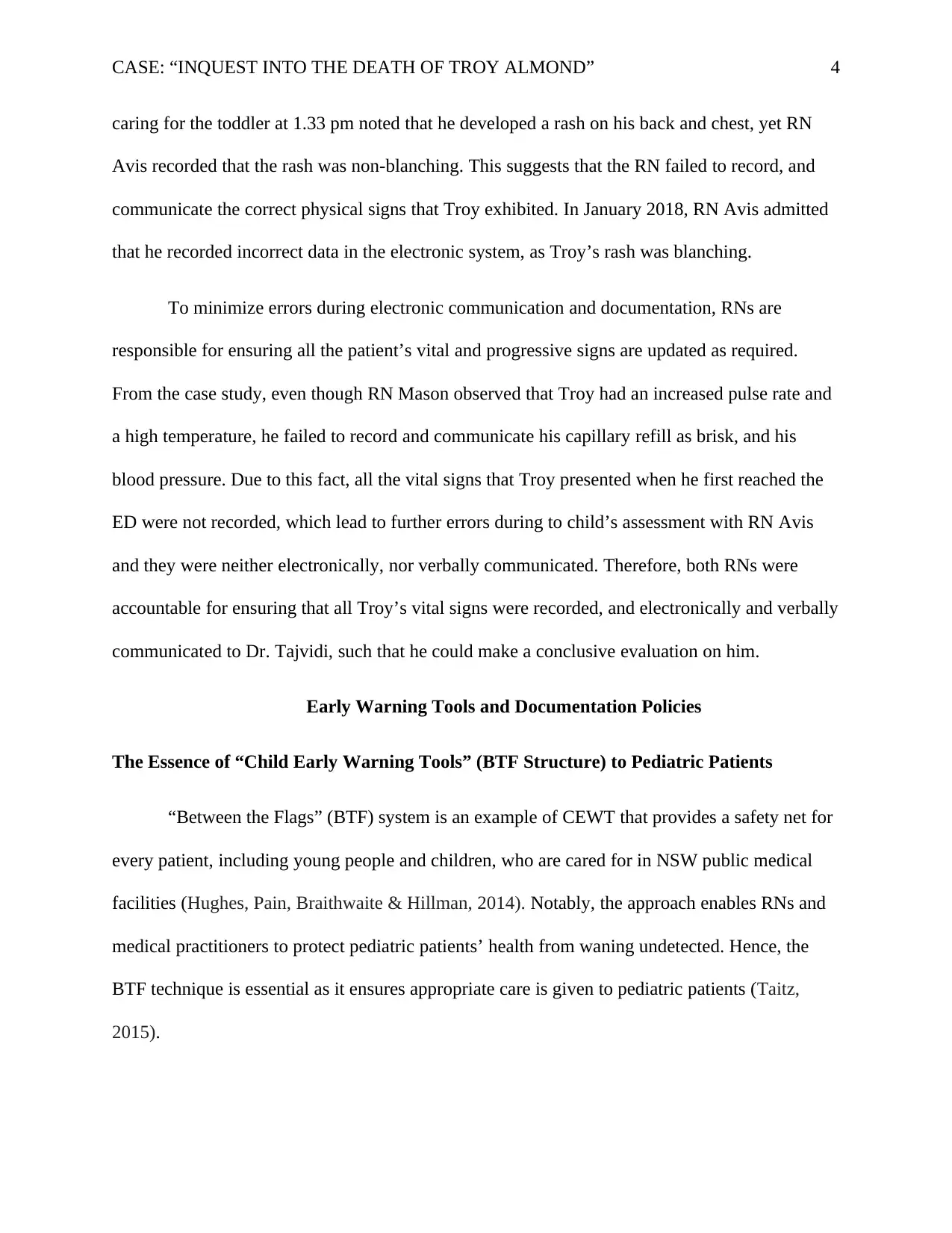
CASE: “INQUEST INTO THE DEATH OF TROY ALMOND” 4
caring for the toddler at 1.33 pm noted that he developed a rash on his back and chest, yet RN
Avis recorded that the rash was non-blanching. This suggests that the RN failed to record, and
communicate the correct physical signs that Troy exhibited. In January 2018, RN Avis admitted
that he recorded incorrect data in the electronic system, as Troy’s rash was blanching.
To minimize errors during electronic communication and documentation, RNs are
responsible for ensuring all the patient’s vital and progressive signs are updated as required.
From the case study, even though RN Mason observed that Troy had an increased pulse rate and
a high temperature, he failed to record and communicate his capillary refill as brisk, and his
blood pressure. Due to this fact, all the vital signs that Troy presented when he first reached the
ED were not recorded, which lead to further errors during to child’s assessment with RN Avis
and they were neither electronically, nor verbally communicated. Therefore, both RNs were
accountable for ensuring that all Troy’s vital signs were recorded, and electronically and verbally
communicated to Dr. Tajvidi, such that he could make a conclusive evaluation on him.
Early Warning Tools and Documentation Policies
The Essence of “Child Early Warning Tools” (BTF Structure) to Pediatric Patients
“Between the Flags” (BTF) system is an example of CEWT that provides a safety net for
every patient, including young people and children, who are cared for in NSW public medical
facilities (Hughes, Pain, Braithwaite & Hillman, 2014). Notably, the approach enables RNs and
medical practitioners to protect pediatric patients’ health from waning undetected. Hence, the
BTF technique is essential as it ensures appropriate care is given to pediatric patients (Taitz,
2015).
caring for the toddler at 1.33 pm noted that he developed a rash on his back and chest, yet RN
Avis recorded that the rash was non-blanching. This suggests that the RN failed to record, and
communicate the correct physical signs that Troy exhibited. In January 2018, RN Avis admitted
that he recorded incorrect data in the electronic system, as Troy’s rash was blanching.
To minimize errors during electronic communication and documentation, RNs are
responsible for ensuring all the patient’s vital and progressive signs are updated as required.
From the case study, even though RN Mason observed that Troy had an increased pulse rate and
a high temperature, he failed to record and communicate his capillary refill as brisk, and his
blood pressure. Due to this fact, all the vital signs that Troy presented when he first reached the
ED were not recorded, which lead to further errors during to child’s assessment with RN Avis
and they were neither electronically, nor verbally communicated. Therefore, both RNs were
accountable for ensuring that all Troy’s vital signs were recorded, and electronically and verbally
communicated to Dr. Tajvidi, such that he could make a conclusive evaluation on him.
Early Warning Tools and Documentation Policies
The Essence of “Child Early Warning Tools” (BTF Structure) to Pediatric Patients
“Between the Flags” (BTF) system is an example of CEWT that provides a safety net for
every patient, including young people and children, who are cared for in NSW public medical
facilities (Hughes, Pain, Braithwaite & Hillman, 2014). Notably, the approach enables RNs and
medical practitioners to protect pediatric patients’ health from waning undetected. Hence, the
BTF technique is essential as it ensures appropriate care is given to pediatric patients (Taitz,
2015).
Paraphrase This Document
Need a fresh take? Get an instant paraphrase of this document with our AI Paraphraser
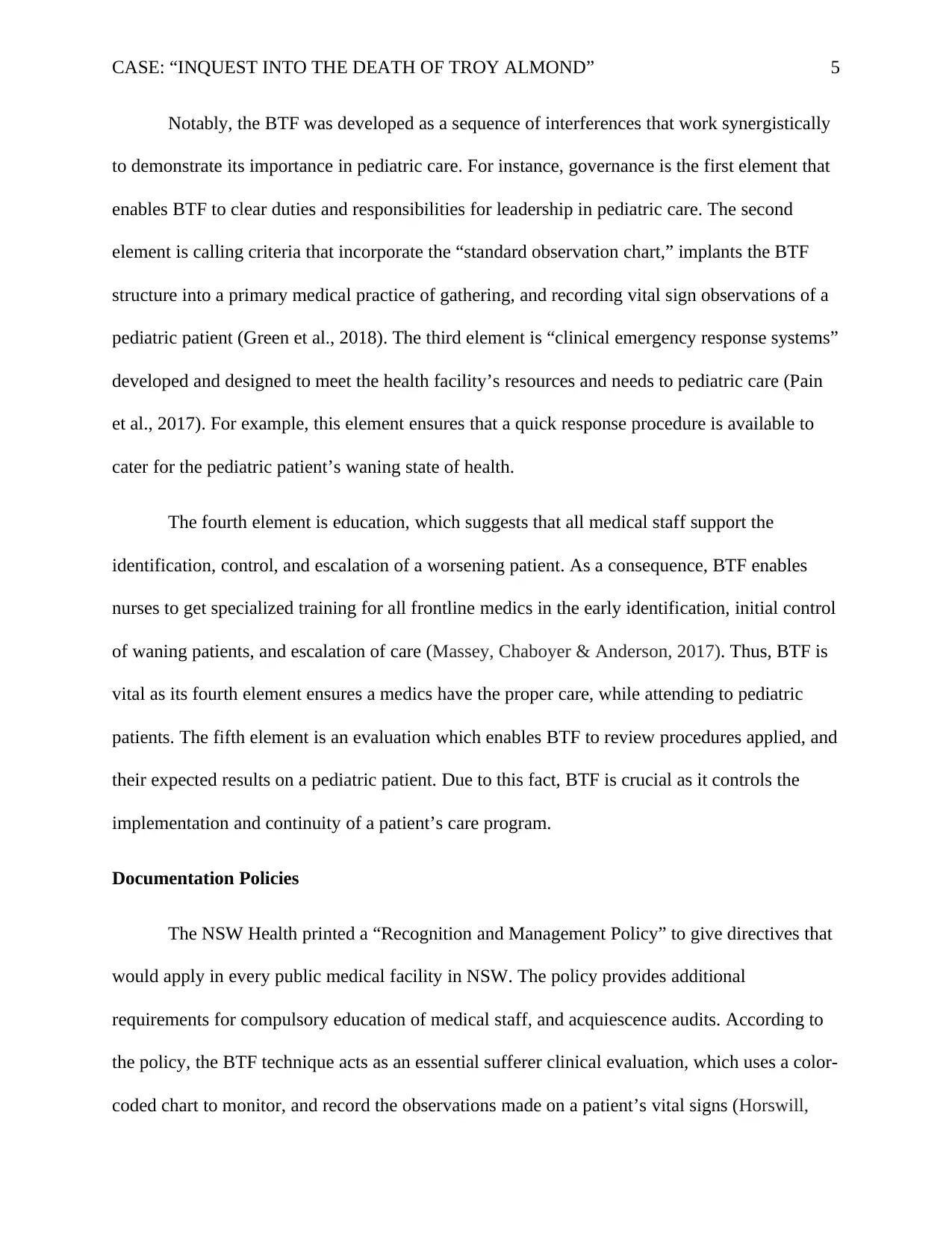
CASE: “INQUEST INTO THE DEATH OF TROY ALMOND” 5
Notably, the BTF was developed as a sequence of interferences that work synergistically
to demonstrate its importance in pediatric care. For instance, governance is the first element that
enables BTF to clear duties and responsibilities for leadership in pediatric care. The second
element is calling criteria that incorporate the “standard observation chart,” implants the BTF
structure into a primary medical practice of gathering, and recording vital sign observations of a
pediatric patient (Green et al., 2018). The third element is “clinical emergency response systems”
developed and designed to meet the health facility’s resources and needs to pediatric care (Pain
et al., 2017). For example, this element ensures that a quick response procedure is available to
cater for the pediatric patient’s waning state of health.
The fourth element is education, which suggests that all medical staff support the
identification, control, and escalation of a worsening patient. As a consequence, BTF enables
nurses to get specialized training for all frontline medics in the early identification, initial control
of waning patients, and escalation of care (Massey, Chaboyer & Anderson, 2017). Thus, BTF is
vital as its fourth element ensures a medics have the proper care, while attending to pediatric
patients. The fifth element is an evaluation which enables BTF to review procedures applied, and
their expected results on a pediatric patient. Due to this fact, BTF is crucial as it controls the
implementation and continuity of a patient’s care program.
Documentation Policies
The NSW Health printed a “Recognition and Management Policy” to give directives that
would apply in every public medical facility in NSW. The policy provides additional
requirements for compulsory education of medical staff, and acquiescence audits. According to
the policy, the BTF technique acts as an essential sufferer clinical evaluation, which uses a color-
coded chart to monitor, and record the observations made on a patient’s vital signs (Horswill,
Notably, the BTF was developed as a sequence of interferences that work synergistically
to demonstrate its importance in pediatric care. For instance, governance is the first element that
enables BTF to clear duties and responsibilities for leadership in pediatric care. The second
element is calling criteria that incorporate the “standard observation chart,” implants the BTF
structure into a primary medical practice of gathering, and recording vital sign observations of a
pediatric patient (Green et al., 2018). The third element is “clinical emergency response systems”
developed and designed to meet the health facility’s resources and needs to pediatric care (Pain
et al., 2017). For example, this element ensures that a quick response procedure is available to
cater for the pediatric patient’s waning state of health.
The fourth element is education, which suggests that all medical staff support the
identification, control, and escalation of a worsening patient. As a consequence, BTF enables
nurses to get specialized training for all frontline medics in the early identification, initial control
of waning patients, and escalation of care (Massey, Chaboyer & Anderson, 2017). Thus, BTF is
vital as its fourth element ensures a medics have the proper care, while attending to pediatric
patients. The fifth element is an evaluation which enables BTF to review procedures applied, and
their expected results on a pediatric patient. Due to this fact, BTF is crucial as it controls the
implementation and continuity of a patient’s care program.
Documentation Policies
The NSW Health printed a “Recognition and Management Policy” to give directives that
would apply in every public medical facility in NSW. The policy provides additional
requirements for compulsory education of medical staff, and acquiescence audits. According to
the policy, the BTF technique acts as an essential sufferer clinical evaluation, which uses a color-
coded chart to monitor, and record the observations made on a patient’s vital signs (Horswill,
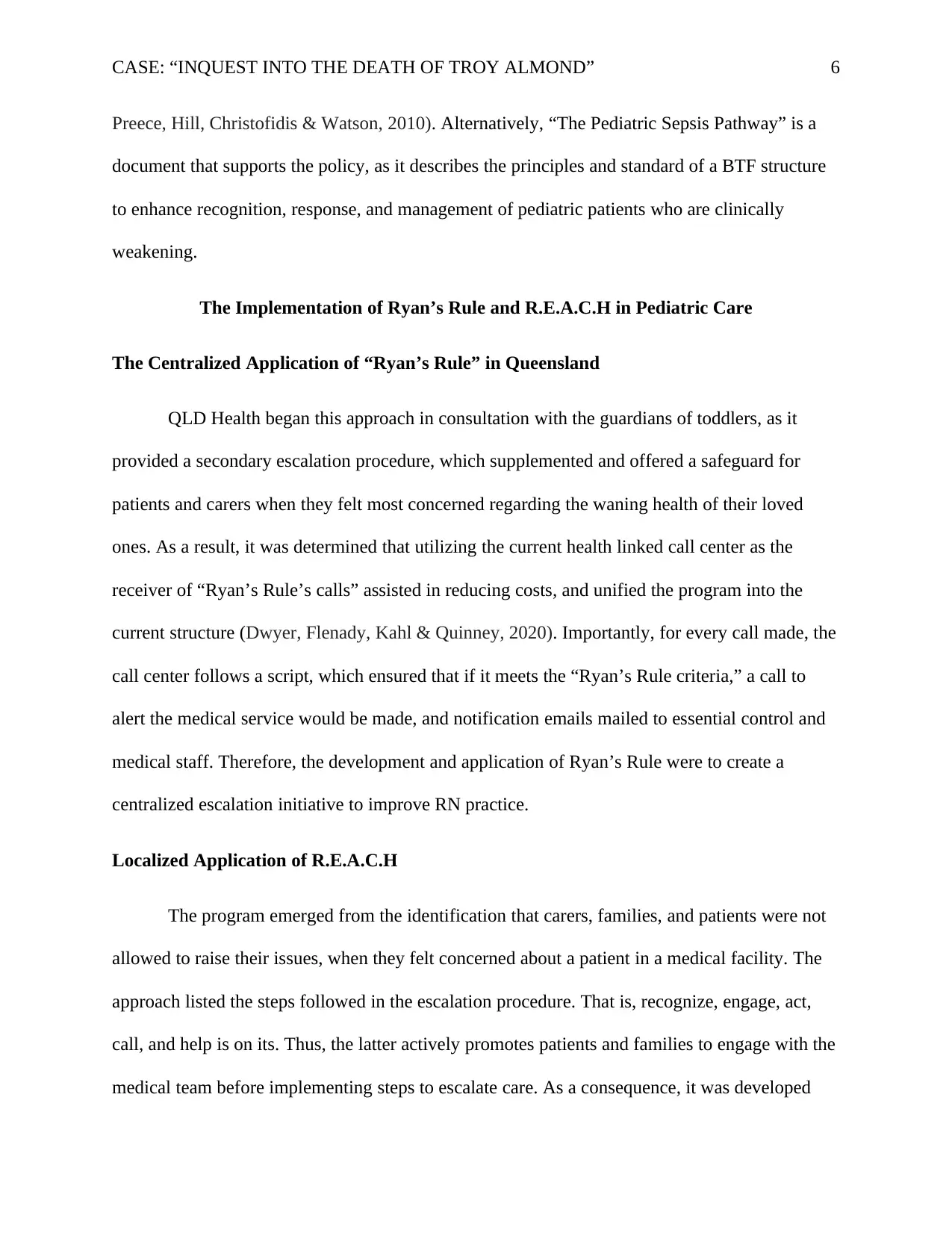
CASE: “INQUEST INTO THE DEATH OF TROY ALMOND” 6
Preece, Hill, Christofidis & Watson, 2010). Alternatively, “The Pediatric Sepsis Pathway” is a
document that supports the policy, as it describes the principles and standard of a BTF structure
to enhance recognition, response, and management of pediatric patients who are clinically
weakening.
The Implementation of Ryan’s Rule and R.E.A.C.H in Pediatric Care
The Centralized Application of “Ryan’s Rule” in Queensland
QLD Health began this approach in consultation with the guardians of toddlers, as it
provided a secondary escalation procedure, which supplemented and offered a safeguard for
patients and carers when they felt most concerned regarding the waning health of their loved
ones. As a result, it was determined that utilizing the current health linked call center as the
receiver of “Ryan’s Rule’s calls” assisted in reducing costs, and unified the program into the
current structure (Dwyer, Flenady, Kahl & Quinney, 2020). Importantly, for every call made, the
call center follows a script, which ensured that if it meets the “Ryan’s Rule criteria,” a call to
alert the medical service would be made, and notification emails mailed to essential control and
medical staff. Therefore, the development and application of Ryan’s Rule were to create a
centralized escalation initiative to improve RN practice.
Localized Application of R.E.A.C.H
The program emerged from the identification that carers, families, and patients were not
allowed to raise their issues, when they felt concerned about a patient in a medical facility. The
approach listed the steps followed in the escalation procedure. That is, recognize, engage, act,
call, and help is on its. Thus, the latter actively promotes patients and families to engage with the
medical team before implementing steps to escalate care. As a consequence, it was developed
Preece, Hill, Christofidis & Watson, 2010). Alternatively, “The Pediatric Sepsis Pathway” is a
document that supports the policy, as it describes the principles and standard of a BTF structure
to enhance recognition, response, and management of pediatric patients who are clinically
weakening.
The Implementation of Ryan’s Rule and R.E.A.C.H in Pediatric Care
The Centralized Application of “Ryan’s Rule” in Queensland
QLD Health began this approach in consultation with the guardians of toddlers, as it
provided a secondary escalation procedure, which supplemented and offered a safeguard for
patients and carers when they felt most concerned regarding the waning health of their loved
ones. As a result, it was determined that utilizing the current health linked call center as the
receiver of “Ryan’s Rule’s calls” assisted in reducing costs, and unified the program into the
current structure (Dwyer, Flenady, Kahl & Quinney, 2020). Importantly, for every call made, the
call center follows a script, which ensured that if it meets the “Ryan’s Rule criteria,” a call to
alert the medical service would be made, and notification emails mailed to essential control and
medical staff. Therefore, the development and application of Ryan’s Rule were to create a
centralized escalation initiative to improve RN practice.
Localized Application of R.E.A.C.H
The program emerged from the identification that carers, families, and patients were not
allowed to raise their issues, when they felt concerned about a patient in a medical facility. The
approach listed the steps followed in the escalation procedure. That is, recognize, engage, act,
call, and help is on its. Thus, the latter actively promotes patients and families to engage with the
medical team before implementing steps to escalate care. As a consequence, it was developed
⊘ This is a preview!⊘
Do you want full access?
Subscribe today to unlock all pages.

Trusted by 1+ million students worldwide
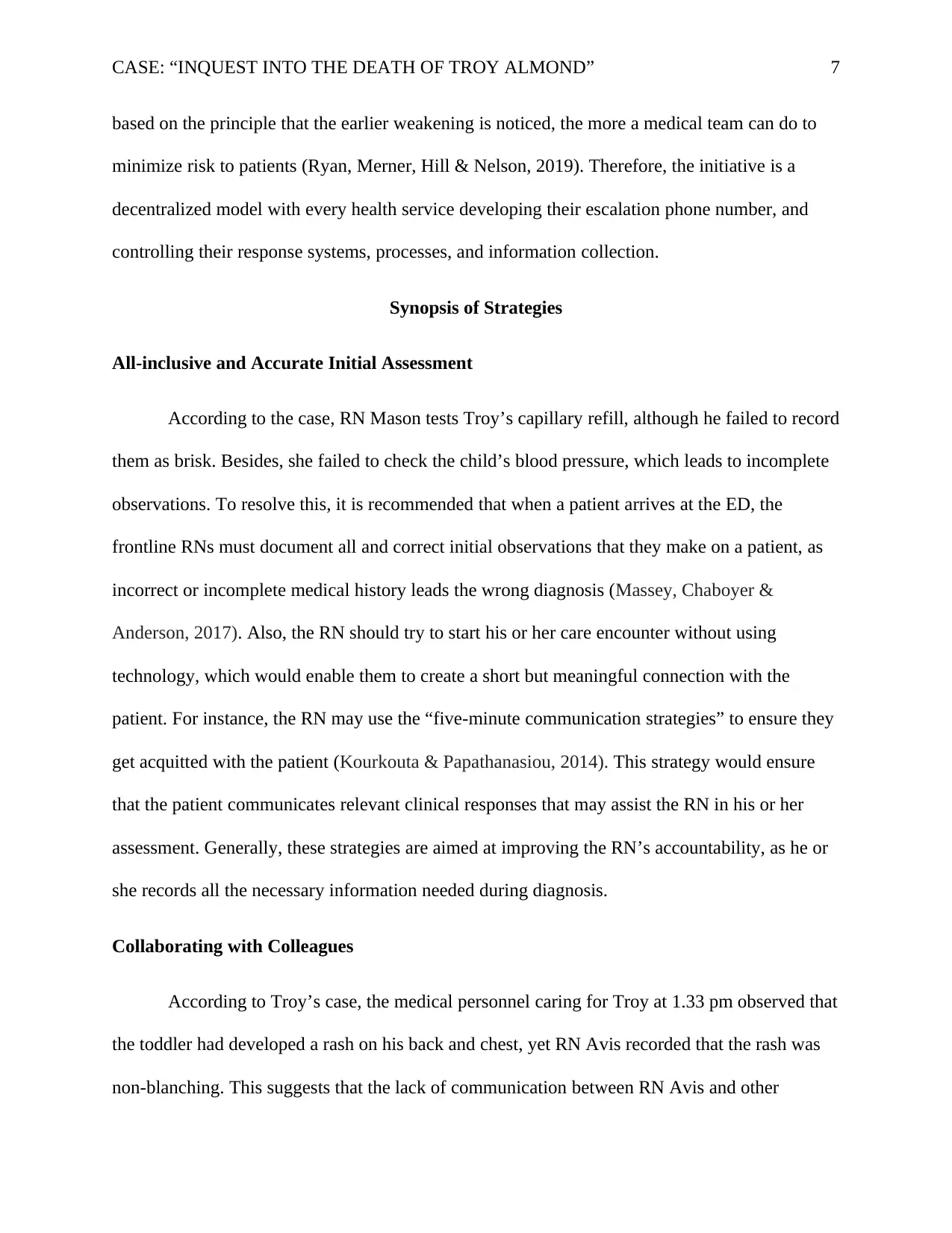
CASE: “INQUEST INTO THE DEATH OF TROY ALMOND” 7
based on the principle that the earlier weakening is noticed, the more a medical team can do to
minimize risk to patients (Ryan, Merner, Hill & Nelson, 2019). Therefore, the initiative is a
decentralized model with every health service developing their escalation phone number, and
controlling their response systems, processes, and information collection.
Synopsis of Strategies
All-inclusive and Accurate Initial Assessment
According to the case, RN Mason tests Troy’s capillary refill, although he failed to record
them as brisk. Besides, she failed to check the child’s blood pressure, which leads to incomplete
observations. To resolve this, it is recommended that when a patient arrives at the ED, the
frontline RNs must document all and correct initial observations that they make on a patient, as
incorrect or incomplete medical history leads the wrong diagnosis (Massey, Chaboyer &
Anderson, 2017). Also, the RN should try to start his or her care encounter without using
technology, which would enable them to create a short but meaningful connection with the
patient. For instance, the RN may use the “five-minute communication strategies” to ensure they
get acquitted with the patient (Kourkouta & Papathanasiou, 2014). This strategy would ensure
that the patient communicates relevant clinical responses that may assist the RN in his or her
assessment. Generally, these strategies are aimed at improving the RN’s accountability, as he or
she records all the necessary information needed during diagnosis.
Collaborating with Colleagues
According to Troy’s case, the medical personnel caring for Troy at 1.33 pm observed that
the toddler had developed a rash on his back and chest, yet RN Avis recorded that the rash was
non-blanching. This suggests that the lack of communication between RN Avis and other
based on the principle that the earlier weakening is noticed, the more a medical team can do to
minimize risk to patients (Ryan, Merner, Hill & Nelson, 2019). Therefore, the initiative is a
decentralized model with every health service developing their escalation phone number, and
controlling their response systems, processes, and information collection.
Synopsis of Strategies
All-inclusive and Accurate Initial Assessment
According to the case, RN Mason tests Troy’s capillary refill, although he failed to record
them as brisk. Besides, she failed to check the child’s blood pressure, which leads to incomplete
observations. To resolve this, it is recommended that when a patient arrives at the ED, the
frontline RNs must document all and correct initial observations that they make on a patient, as
incorrect or incomplete medical history leads the wrong diagnosis (Massey, Chaboyer &
Anderson, 2017). Also, the RN should try to start his or her care encounter without using
technology, which would enable them to create a short but meaningful connection with the
patient. For instance, the RN may use the “five-minute communication strategies” to ensure they
get acquitted with the patient (Kourkouta & Papathanasiou, 2014). This strategy would ensure
that the patient communicates relevant clinical responses that may assist the RN in his or her
assessment. Generally, these strategies are aimed at improving the RN’s accountability, as he or
she records all the necessary information needed during diagnosis.
Collaborating with Colleagues
According to Troy’s case, the medical personnel caring for Troy at 1.33 pm observed that
the toddler had developed a rash on his back and chest, yet RN Avis recorded that the rash was
non-blanching. This suggests that the lack of communication between RN Avis and other
Paraphrase This Document
Need a fresh take? Get an instant paraphrase of this document with our AI Paraphraser
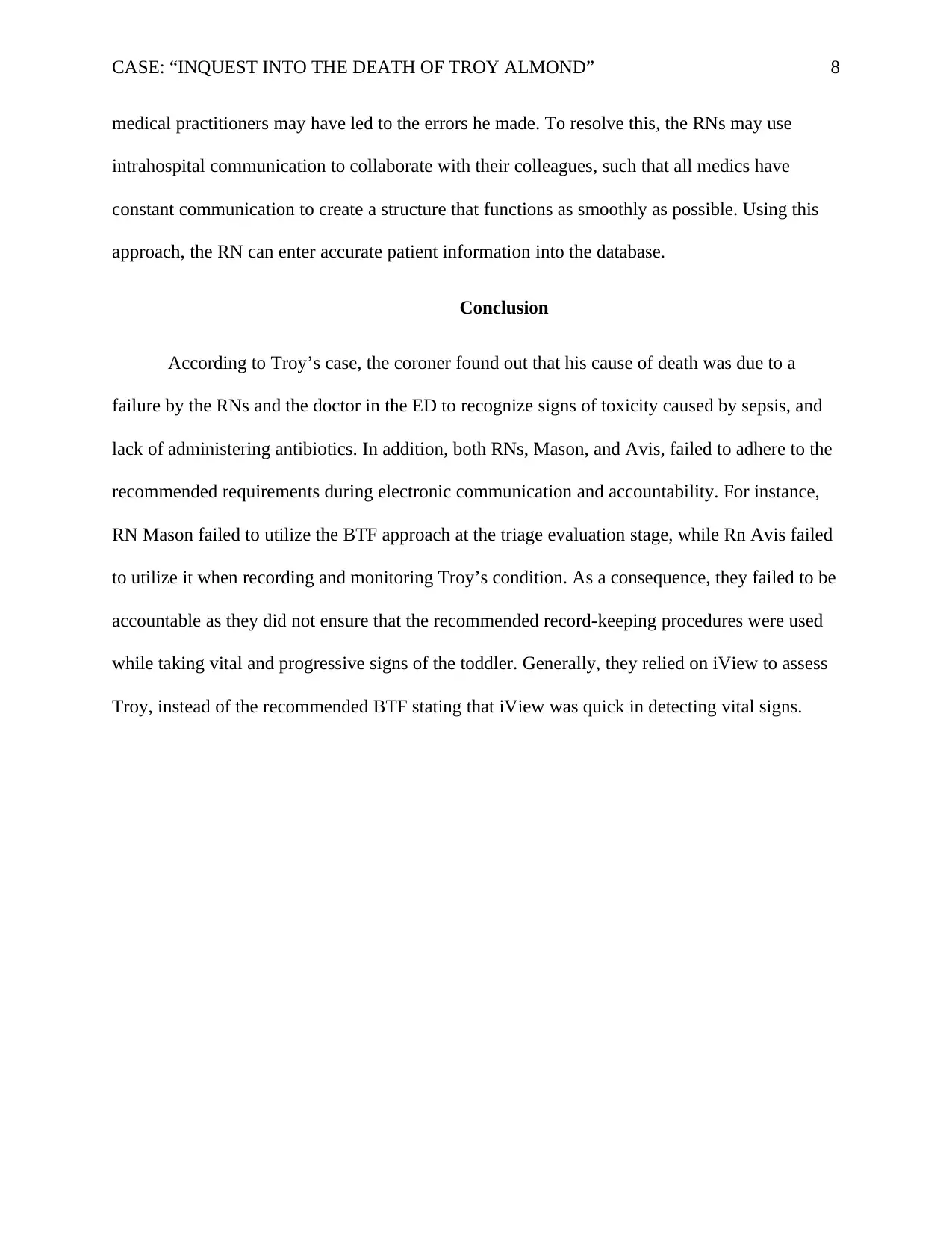
CASE: “INQUEST INTO THE DEATH OF TROY ALMOND” 8
medical practitioners may have led to the errors he made. To resolve this, the RNs may use
intrahospital communication to collaborate with their colleagues, such that all medics have
constant communication to create a structure that functions as smoothly as possible. Using this
approach, the RN can enter accurate patient information into the database.
Conclusion
According to Troy’s case, the coroner found out that his cause of death was due to a
failure by the RNs and the doctor in the ED to recognize signs of toxicity caused by sepsis, and
lack of administering antibiotics. In addition, both RNs, Mason, and Avis, failed to adhere to the
recommended requirements during electronic communication and accountability. For instance,
RN Mason failed to utilize the BTF approach at the triage evaluation stage, while Rn Avis failed
to utilize it when recording and monitoring Troy’s condition. As a consequence, they failed to be
accountable as they did not ensure that the recommended record-keeping procedures were used
while taking vital and progressive signs of the toddler. Generally, they relied on iView to assess
Troy, instead of the recommended BTF stating that iView was quick in detecting vital signs.
medical practitioners may have led to the errors he made. To resolve this, the RNs may use
intrahospital communication to collaborate with their colleagues, such that all medics have
constant communication to create a structure that functions as smoothly as possible. Using this
approach, the RN can enter accurate patient information into the database.
Conclusion
According to Troy’s case, the coroner found out that his cause of death was due to a
failure by the RNs and the doctor in the ED to recognize signs of toxicity caused by sepsis, and
lack of administering antibiotics. In addition, both RNs, Mason, and Avis, failed to adhere to the
recommended requirements during electronic communication and accountability. For instance,
RN Mason failed to utilize the BTF approach at the triage evaluation stage, while Rn Avis failed
to utilize it when recording and monitoring Troy’s condition. As a consequence, they failed to be
accountable as they did not ensure that the recommended record-keeping procedures were used
while taking vital and progressive signs of the toddler. Generally, they relied on iView to assess
Troy, instead of the recommended BTF stating that iView was quick in detecting vital signs.
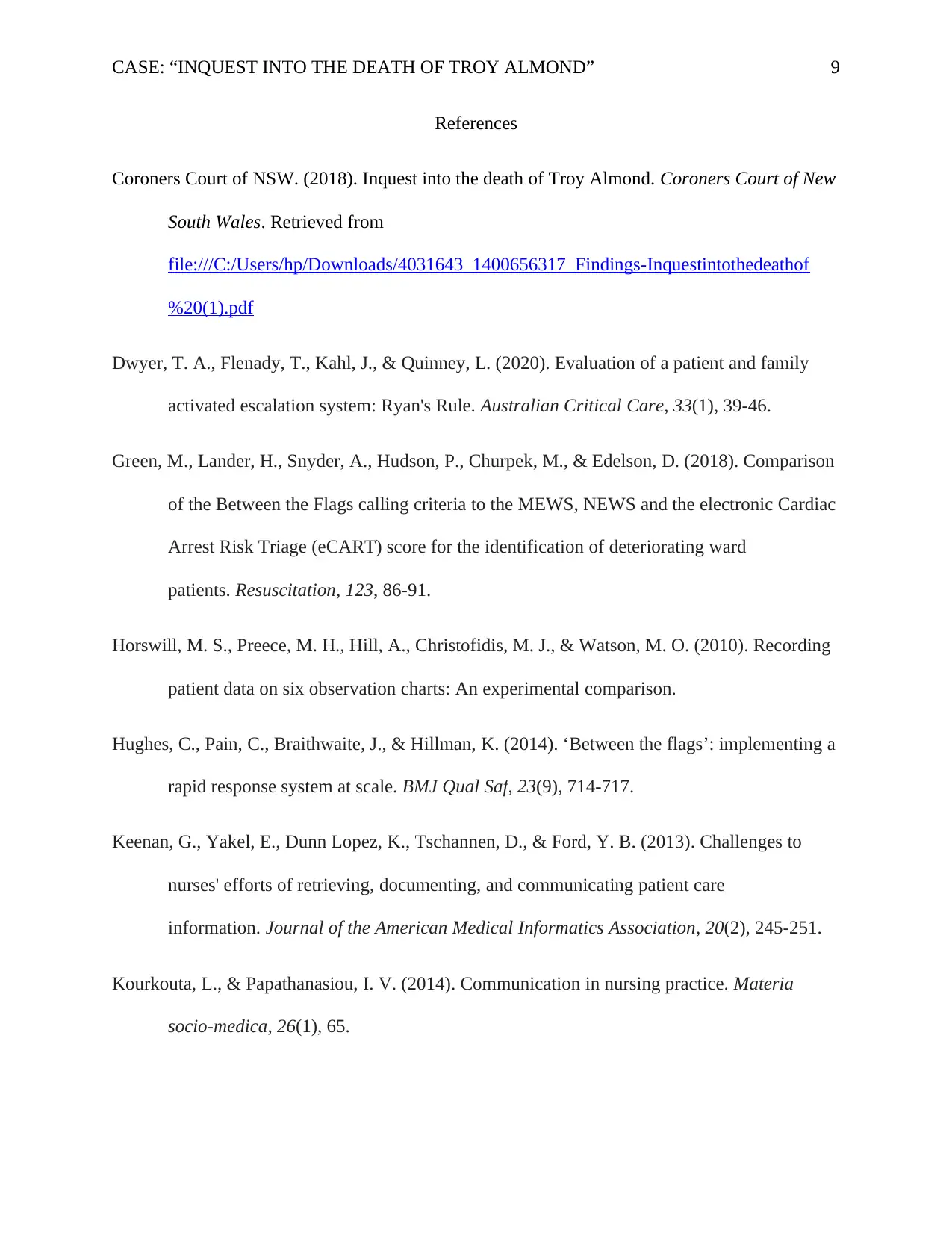
CASE: “INQUEST INTO THE DEATH OF TROY ALMOND” 9
References
Coroners Court of NSW. (2018). Inquest into the death of Troy Almond. Coroners Court of New
South Wales. Retrieved from
file:///C:/Users/hp/Downloads/4031643_1400656317_Findings-Inquestintothedeathof
%20(1).pdf
Dwyer, T. A., Flenady, T., Kahl, J., & Quinney, L. (2020). Evaluation of a patient and family
activated escalation system: Ryan's Rule. Australian Critical Care, 33(1), 39-46.
Green, M., Lander, H., Snyder, A., Hudson, P., Churpek, M., & Edelson, D. (2018). Comparison
of the Between the Flags calling criteria to the MEWS, NEWS and the electronic Cardiac
Arrest Risk Triage (eCART) score for the identification of deteriorating ward
patients. Resuscitation, 123, 86-91.
Horswill, M. S., Preece, M. H., Hill, A., Christofidis, M. J., & Watson, M. O. (2010). Recording
patient data on six observation charts: An experimental comparison.
Hughes, C., Pain, C., Braithwaite, J., & Hillman, K. (2014). ‘Between the flags’: implementing a
rapid response system at scale. BMJ Qual Saf, 23(9), 714-717.
Keenan, G., Yakel, E., Dunn Lopez, K., Tschannen, D., & Ford, Y. B. (2013). Challenges to
nurses' efforts of retrieving, documenting, and communicating patient care
information. Journal of the American Medical Informatics Association, 20(2), 245-251.
Kourkouta, L., & Papathanasiou, I. V. (2014). Communication in nursing practice. Materia
socio-medica, 26(1), 65.
References
Coroners Court of NSW. (2018). Inquest into the death of Troy Almond. Coroners Court of New
South Wales. Retrieved from
file:///C:/Users/hp/Downloads/4031643_1400656317_Findings-Inquestintothedeathof
%20(1).pdf
Dwyer, T. A., Flenady, T., Kahl, J., & Quinney, L. (2020). Evaluation of a patient and family
activated escalation system: Ryan's Rule. Australian Critical Care, 33(1), 39-46.
Green, M., Lander, H., Snyder, A., Hudson, P., Churpek, M., & Edelson, D. (2018). Comparison
of the Between the Flags calling criteria to the MEWS, NEWS and the electronic Cardiac
Arrest Risk Triage (eCART) score for the identification of deteriorating ward
patients. Resuscitation, 123, 86-91.
Horswill, M. S., Preece, M. H., Hill, A., Christofidis, M. J., & Watson, M. O. (2010). Recording
patient data on six observation charts: An experimental comparison.
Hughes, C., Pain, C., Braithwaite, J., & Hillman, K. (2014). ‘Between the flags’: implementing a
rapid response system at scale. BMJ Qual Saf, 23(9), 714-717.
Keenan, G., Yakel, E., Dunn Lopez, K., Tschannen, D., & Ford, Y. B. (2013). Challenges to
nurses' efforts of retrieving, documenting, and communicating patient care
information. Journal of the American Medical Informatics Association, 20(2), 245-251.
Kourkouta, L., & Papathanasiou, I. V. (2014). Communication in nursing practice. Materia
socio-medica, 26(1), 65.
⊘ This is a preview!⊘
Do you want full access?
Subscribe today to unlock all pages.

Trusted by 1+ million students worldwide
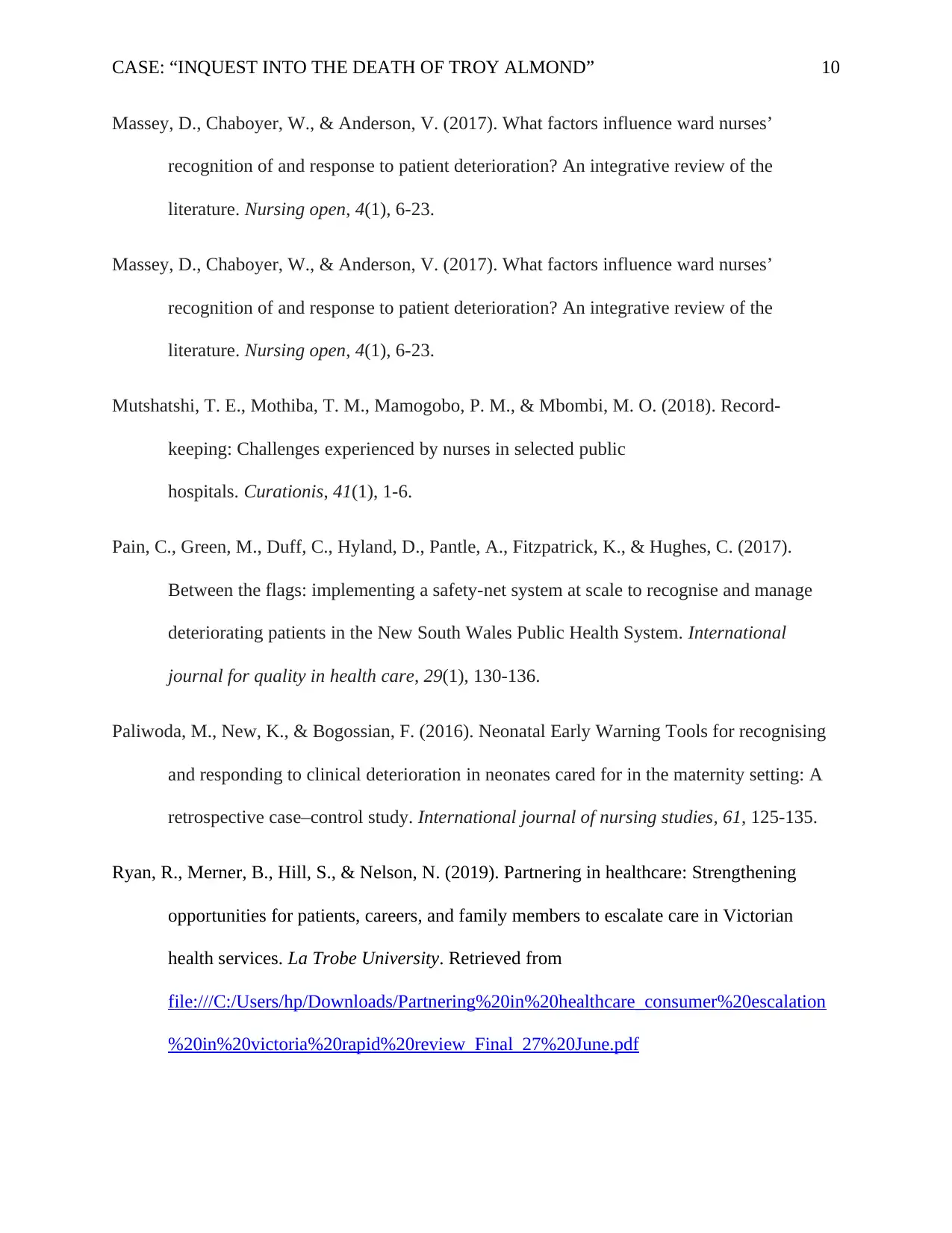
CASE: “INQUEST INTO THE DEATH OF TROY ALMOND” 10
Massey, D., Chaboyer, W., & Anderson, V. (2017). What factors influence ward nurses’
recognition of and response to patient deterioration? An integrative review of the
literature. Nursing open, 4(1), 6-23.
Massey, D., Chaboyer, W., & Anderson, V. (2017). What factors influence ward nurses’
recognition of and response to patient deterioration? An integrative review of the
literature. Nursing open, 4(1), 6-23.
Mutshatshi, T. E., Mothiba, T. M., Mamogobo, P. M., & Mbombi, M. O. (2018). Record-
keeping: Challenges experienced by nurses in selected public
hospitals. Curationis, 41(1), 1-6.
Pain, C., Green, M., Duff, C., Hyland, D., Pantle, A., Fitzpatrick, K., & Hughes, C. (2017).
Between the flags: implementing a safety-net system at scale to recognise and manage
deteriorating patients in the New South Wales Public Health System. International
journal for quality in health care, 29(1), 130-136.
Paliwoda, M., New, K., & Bogossian, F. (2016). Neonatal Early Warning Tools for recognising
and responding to clinical deterioration in neonates cared for in the maternity setting: A
retrospective case–control study. International journal of nursing studies, 61, 125-135.
Ryan, R., Merner, B., Hill, S., & Nelson, N. (2019). Partnering in healthcare: Strengthening
opportunities for patients, careers, and family members to escalate care in Victorian
health services. La Trobe University. Retrieved from
file:///C:/Users/hp/Downloads/Partnering%20in%20healthcare_consumer%20escalation
%20in%20victoria%20rapid%20review_Final_27%20June.pdf
Massey, D., Chaboyer, W., & Anderson, V. (2017). What factors influence ward nurses’
recognition of and response to patient deterioration? An integrative review of the
literature. Nursing open, 4(1), 6-23.
Massey, D., Chaboyer, W., & Anderson, V. (2017). What factors influence ward nurses’
recognition of and response to patient deterioration? An integrative review of the
literature. Nursing open, 4(1), 6-23.
Mutshatshi, T. E., Mothiba, T. M., Mamogobo, P. M., & Mbombi, M. O. (2018). Record-
keeping: Challenges experienced by nurses in selected public
hospitals. Curationis, 41(1), 1-6.
Pain, C., Green, M., Duff, C., Hyland, D., Pantle, A., Fitzpatrick, K., & Hughes, C. (2017).
Between the flags: implementing a safety-net system at scale to recognise and manage
deteriorating patients in the New South Wales Public Health System. International
journal for quality in health care, 29(1), 130-136.
Paliwoda, M., New, K., & Bogossian, F. (2016). Neonatal Early Warning Tools for recognising
and responding to clinical deterioration in neonates cared for in the maternity setting: A
retrospective case–control study. International journal of nursing studies, 61, 125-135.
Ryan, R., Merner, B., Hill, S., & Nelson, N. (2019). Partnering in healthcare: Strengthening
opportunities for patients, careers, and family members to escalate care in Victorian
health services. La Trobe University. Retrieved from
file:///C:/Users/hp/Downloads/Partnering%20in%20healthcare_consumer%20escalation
%20in%20victoria%20rapid%20review_Final_27%20June.pdf
Paraphrase This Document
Need a fresh take? Get an instant paraphrase of this document with our AI Paraphraser

CASE: “INQUEST INTO THE DEATH OF TROY ALMOND” 11
Taitz, J. (2015). Building a culture of safety in pediatrics and child health. Current Treatment
Options in Pediatrics, 1(4), 253-261.
Taitz, J. (2015). Building a culture of safety in pediatrics and child health. Current Treatment
Options in Pediatrics, 1(4), 253-261.
1 out of 11
Related Documents
Your All-in-One AI-Powered Toolkit for Academic Success.
+13062052269
info@desklib.com
Available 24*7 on WhatsApp / Email
![[object Object]](/_next/static/media/star-bottom.7253800d.svg)
Unlock your academic potential
Copyright © 2020–2025 A2Z Services. All Rights Reserved. Developed and managed by ZUCOL.



